

Map © OpenStreetMap contributors (info) | |
|
France Capital Government Area Population Language Currency |
Paris Republic 543 970 km2 56 700 000 French Euro (EUR) |
By European standards, France is a large country with a number of different regions and vastly differing climates from north to south. It has coastlines on the North Sea, the Atlantic Ocean and the Mediterranean Sea, and land borders with Spain, Andorra, Belgium, Luxembourg, Germany, Switzerland, Italy and Monaco. France is the most popular tourist destination in the world. | |
If you enjoyed reading this, please send me an email. All correspondence is appreciated!
[Tuesday 14 September 2004 : Cape Town, South Africa] An early-afternoon domestic flight on South African Airways took us from Cape Town to Johannesburg, where the formality of changing planes for the international flight to Paris proved to be too much for the airline to handle. Our boarding passes were messed up and we had to wait in endless queues for officious airline staff to confer, send faxes and make phone calls before we were finally allowed onto the plane.
[Wednesday 15 September : Paris, France] We landed at Charles de Gaulle Airport outside Paris and took the train (RER) into the city, then caught the Metro (the underground railway system through the centre of Paris) to our hotel on the Left Bank of the river Seine, near Boulevard St Michel. After settling in we strolled over to Ile de la Cite and met Karen's parents outside Notre Dame - they'd been in Paris for three days already. From there we visited the unbelievably ugly Pompideau Centre and then took a boat trip down the Seine, past most of the well-known sights of Paris. Supper was a quick pizza, by which time the lack of sleep from our overnight flight had caught up with us and we all hit the sack early.
[Thursday 16 September : Paris, France] Went to the Eiffel Tower, but incredibly it was shut - there was some kind of strike on. There were barricades up and a sign in French saying exceptionally ferme (literally, "exceptionally closed"). Walked across the Seine to the Arc de Triomphe, climbed to the top and had a magnificent panoramic view of Paris. Then we strolled down the Champs Elysees, through the Tuileries gardens to the Louvre. In the evening we took the Metro to Montmartre and had supper with Karen's parents in a restaurant near the beautiful Sacre Couer cathedral. The cathedral is at the top of quite a steep hill, and the views of Paris from there are stupendous.

[Friday 17 September : Brussels, Belgium] Karen and Scott went with her parents to a cottage (git) in the country they'd booked, while I caught the 09:25 AM Thalys express to Brussels. "Thalys" is the name for the high-speed train (a French TGV, modified to handle the different overhead wire voltages of the various countries it passes through) that runs from Paris to Brussels, Amsterdam and Cologne, and it was an incredible experience - the rail distance from Paris to Brussels is 336 kilometres and the train covered this in only 85 minutes! That is a staggering average speed of 237 kilometres per hour. At times when the tracks were next to freeways the cars looked as if they were crawling along as we blasted past them. There were no stops between Paris and Brussels and the train was rock-steady and virtually silent inside; no shaking, rattling or clacking of wheels. You would hardly know you were moving unless you looked out of the train window and saw the countryside passing by in a blur.
Most international trains to Brussels arrive at Gare du Midi, which is some distance from the city centre (Brussels' smaller central station only handles domestic and local trains). So I had to walk quite a long way from the station through an industrial area before seeing any guest houses or hotels. Shortly before getting to the city centre I came across a very nice looking hotel in a small square so I went inside and enquired about a room. It was pretty expensive, but when I mentioned that I would be staying for two nights not one, the lady at reception immediately dropped the price drastically. I gladly accepted her offer and moved into a semi-luxury room, reflecting that most people who come to Brussels obviously don't stay long. What does that tell you about the city?
[Saturday 18 September : Brussels, Belgium] Breakfast in my semi-luxury hotel was outstanding, and I had three cups of coffee to fortify myself for what I suspected would be a long day of exploring Brussels. And so it proved, but despite the city's reputation as the most boring place in Europe I found it quite interesting. The central square in Brussels (Grand Place) must surely be the most beautiful city square in Europe, if not the world - an expanse of cobbled stones surrounded by venerable old buildings displaying the most exquisite architecture. I also went to (inter alia) the Belgian Comic Strip museum (Herge, the author of Tin Tin, was Belgian), the European Parliament buildings, "Mannekin Pis" (a statue of a small boy relieving himself, which for some odd reason has become the popular symbol of Brussels) and the magnificent Gothic cathedral of St Michael and St Gudula.
[Sunday 19 September : Bruges, Belgium] After another excellent breakfast I checked out of my Brussels hotel and headed down to the train station, intending to get a train to Bruges in the northern Belgian province of Flanders. At the station I found pamphlets, posters and railway staff advertising "TTB Day" (Train-Tram-Bus day), an annual event in Belgium designed to promote the use of public transport. So, just today, I could buy one ticket for ten Euros that would give me unlimited access to any train, tram or bus throughout the entire country for the whole day - a nice stroke of luck, because I'd planned to spend the day on trains exploring anyway.
So I bought a "TTB ticket" and hopped on the first train north to Bruges. Once there I found a place to stay directly across the square from Bruges' train station, dumped my gear then caught another train to the village of Blankenberge on the north coast. Blankenberge is a nondescript but fairly pleasant seaside resort town and I strolled along the pedestrian path between the beachfront shops and the North Sea for a while.
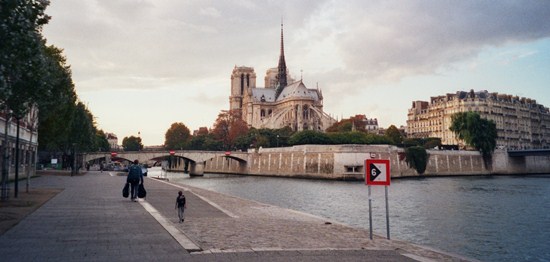
There is a tram that runs along the entire north coast of Belgium, from the border with France at De Panne in the west to the border with the Netherlands at Knokke-Heist in the east and I rode the length of it, from Blankenberge to De Panne then back again all the way to Knokke-Heist. The whole distance from end to end is about 68 kilometres, making it the longest tram line in the world.
I got off the tram several times and explored some of the more interesting-looking places on the way (Ostende and Zeebrugge among others). Virtually the entire Belgian coastline is built-up, with houses and buildings crammed together all the way from France to the Netherlands and hardly any open land. But the tram ride was very pleasant, and the seaside communities are all neat and well-kept (as are most things in Belgium). The seafront promenade of Ostende was crowded with weekend trippers enjoying the good weather before the onset of another severe European winter.
Late in the afternoon I left the tram at Ostende and took a train down to Ghent; the train was so crowded with people heading back home after spending Sunday at the beach that I had to stand in a cramped corner all the way. Ghent is a graceful and charming city (the third largest in Belgium), with a town centre containing a magnificent collection of immaculately preserved medieval buildings, and I enjoyed strolling around in the late summer sunshine.
My final destination of a long and tiring day was Bruges, which I reached just as it was getting dark. Bruges is, if anything, even a better example of medieval Europe than Ghent, but with the added attraction of a system of canals winding between the gracious old buildings. I walked round the cobbled streets, knackered from my exertions of criss-crossing Belgium in one day, but reflecting on what a pleasant country it is. Why is Belgium regarded as one of the least interesting places in Europe to visit? I found it thoroughly enjoyable - every town and city seemed to be neat, clean and well-maintained and the public transport system is incredibly efficient. Not only are the trains and trams fast, frequent, comfortable but all those I rode on were spotlessly clean and quite new. Of course, it helps that the country is small ... and I was lucky in that the very day that I wanted to traverse Belgium was "public transport day" so once I'd bought my TTB ticket in the morning I simply climbed onto any train or tram without further hassle.

[Monday 20 September : Luxembourg City, Luxembourg] I left Bruges early, caught a train back to Brussels and then connected with an inter-city express (ICE) to Luxembourg. My luck was in, because I found a fabulous yet inexpensive hotel in Luxembourg for the next three days - I had a big, airy room in a quiet location near the station and the city centre, with breakfast included. It was undoubtedly one of my most enjoyable overnight stops in all my travels in Europe.
Luxembourg City is an incredibly beautiful place, with two deep gorges cutting right through the city. Much of the old battlements still exist and at the bottom of the main gorge is a well-wooded park containing the plush houses of Luxembourg's well-to-do. I have no hesitation in including Luxembourg on my Most beautiful places in the World list.
[Tuesday 21 September : Luxembourg City, Luxembourg] Walked round the city, visiting (inter alia) the administrative centre of the European government, the casemates (old city walls), Notre Dame cathedral with its sombre crypt beneath which lie the Royal Family's tombs, the Grund and Clausen districts as well as the park at the bottom of the Petrusse gorge. There are several bridges across the two gorges and I strolled over three of them.
[Wednesday 22 September : Luxembourg City, Luxembourg] Explored the Luxembourg countryside via the extremely efficient train and bus network, visiting the Ardennes forest in the north (including some delightful villages such as Wiltz, Diekerch and Kautenbach), the industrial area in the south (Esch-sur-Alzette) and as far as the German border in the east at Wasserbillig. In Wasserbillig I managed the rather unusual achievement of walking from one country to another when I strolled over the Moselle River bridge and thus crossed into Germany from Luxembourg - the Moselle River is the border between the two at that point. Of course, in these days of European unity there was no border post or passport check.

[Thursday 23 September : Dijon, France] Took the train south to Dijon in Burgundy in cold, grey weather, with persistent rain most of the day. I had a two hour wait in Metz where I had to change trains, so I walked around the city, but unfortunately it rained non-stop and the place looked gloomy, dark and depressing. The train from Metz got into Dijon in mid-afternoon; thankfully the rain had stopped by then.
It was a short walk from the train station to the main tourist office in Dijon, where a fairly unhelpful girl recommended a succession of ludicrously expensive hotels to me. When I asked about a budget-looking hotel down the road that I'd walked past two minutes before, she shook her head and professed ignorance. Either she did not know about it (which makes you question why she was working in the tourist information office at all) or it was too cheap for her taste and beneath her dignity even to acknowledge its existence. Either way, I declined her offer of a room at the 750 Euros-per-night Sheraton Hotel and walked back down the street to the place I'd seen. It turned out to be a typical French family hotel, in an old creaking building with a narrow stairway and wooden beams everywhere. But it was very reasonably priced, conveniently close to the train station and the city centre, and I secured a small but perfectly adequate room for the night.
The old part of Dijon is remarkably well preserved and it's small enough that it can easily be explored on foot in a couple of hours - which is just as well because that's all the time I had.
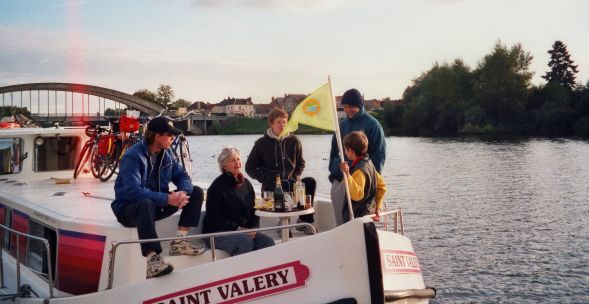

[Friday 24 September : Dompierre sur Bresbe, France] In the morning I trudged back down to Dijon's train station and took a succession of small country trains via the little villages of Montchanin and Paray-le-Monial to get to Dompierre. After getting off the train at Dompierre I walked into town, asked directions from a bunch of sozzled Frenchmen in a bar then walked three kilometres to the Canal du Lateral, where I met up with Karen, Scott and her parents on the canal barge that they had rented for the following week. They had taken a taxi there from the cottage they'd been staying in for the previous week.
The five of us (Paul, Karen, Scott, Wilf and Wendy) set off that afternoon down the canal, and after we'd tied up for the night Karen's brother and sister-in-law (Tom and Dain) cycled up the towpath and joined us on the boat; they had flown to Toulouse a week before and cycled up from there. So the boat then had seven of us on board (six adults and one child), resulting in the space being pretty cramped at times.
[Saturday 25 September : Decize, France] Ambled up the Canal du Lateral on our barge, opening and closing "locks" on the way. Canal locks are used to regulate the flow of water and raise or lower the water level on slopes.
[Sunday 26 September : Cercy-la-Tours, France] We turned north onto the Canal du Nivernais shortly after leaving our overnight spot at the rather run-down town of Decize. Cercy-la-Tours, however, was a charming little village.
[Monday 27 September : Anizy, France] More canal ambling ... What a great way to travel - pootle along the water, drinking tea and eating biscuits, baguettes and croissants. Occasionally we took the bicycles off the boat and cycled along the towpath, or rode into nearby villages to buy food.
[Tuesday 28 September : Chatillon-en-Bazois, France] Had a superb omelette and chips for dinner at an old stone restaurant in the village of Chatillon (where we tied the barge up for the night). The French do know how to make omelettes ...
[Wednesday 29 September : Port Brule, France] A fabulous day of boating - we went through an exquisite landscape of forests, tunnels and deep ravines, and tied up for the night in the tiny but beautiful settlement of Port Brule. The canal went through a dark tunnel for several hundred metres at one point; an eerie feeling.
[Thursday 30 September : Corbigny, France] Our last day on the boat, and it was a hard one - 24 locks, of which 16 were one after the other. We docked for the night at the boat base, which was quite a distance from the village of Corbigny so five of us (Karen, Paul, Scott, Tom and Dain) cycled into town to get food. It was a pleasant ride through the French countryside but we got lost coming back. Eventually we intersected the canal a long way upstream from where we were docked and had to ride back down the towpath to the barge. Had a fabulous shower at the boat base - the showers on the barge were cramped and uncomfortable.

[Friday 1 October : Lyon, France] Early in the morning we handed back the keys to our floating home of the last seven nights and piled into a taxi for the short trip to Corbigny. Although Corbigny has a train station and operational railway lines, passenger trains to the village were stopped several years ago; that meant a bus ride to Clamecy, from where we caught a succession of trains for the rest of the day. The first train was from Clamecy to Auxerre (we just made that one by a few SECONDS), followed by Auxerre to Laroche-Migennes, Laroche to Dijon, Dijon to Lyon Part-Dieu and Lyon Part-Dieu (the train station in the new financial district of Lyon) to Lyon Perrache (the station near the centre of the city). A long, tiring day ... we hadn't planned on staying over in Lyon, but by the time we arrived there at about 5:30 PM we were so exhausted that it was a relief to check into a cheap hotel near the train station.
[Saturday 2 October : Lyon, France] Explored Lyon, the second biggest city in France. It has a well-preserved old town, including some impressive Roman ruins and a HUGE cathedral that contains two entire churches, one on top of the other. The old town is steep and cobbled, and many buildings have rambling, picturesque courtyards that you can wander around. However, two days in Lyon was enough and I can't imagine we'd ever want to return; it is generally a nondescript and uninspiring sort of place. The city's central square is not even paved - it is just a vast expanse of hard-packed sand.
[Sunday 3 October : Avignon, France] Took the train south to Avignon in Provence, a charming city entirely surrounded by medieval walls. It's pretty hot this far south and we're all in shorts and T-shirts. For 67 years in the 14'th century Avignon was the residence of the Pope, a contentious period in the history of the Roman Catholic church. Seven successive Popes lived in Avignon, all of them French; the last of these (Gregory XI) moved back to Rome in September 1376. However, this did not end the schism between the French crown and the Papacy - several more "anti popes" stayed on in France after Gregory's move to Rome but they were not recognized by The Vatican. It was only in 1417 that one universally recognized Pope was again accepted by all the various splinter groups in the Church.
The Papal Palace that was used during this schism is now an impressive museum.

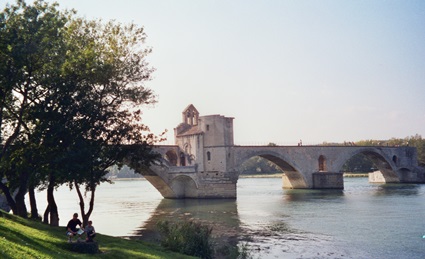
[Monday 4 October : Avignon, France] Explored Avignon and relaxed (which means we caught up on laundry, email and planned our next few days travel). We walked round the city walls and saw the broken Pont du Benezet, the bridge across two rivers and a swamp that was built by a simple peasant (Benezet) who later went on to become a saint. Completed in 1185, this bridge had 22 arches and was almost 900 metres long - a very ambitious undertaking at that time. The bridge was partially washed away and rebuilt at huge expense several times over the centuries, but became increasingly perilous as more arches collapsed and were replaced by unstable wooden supports. A catastrophic flood in 1668 swept away most of the bridge, after which it was abandoned and left to nature. Since then several more arches have collapsed and today only four of the original 22 arches remain intact. That night we had a three course "set menu" supper on the main square.
[Tuesday 5 October : Avignon, France] We caught an early local train from Avignon to the picturesque village of Isle-sur-la-Sorge; the weather was icy cold and we walked briskly round the town, trying to get warm. Isle-sur-la-Sorge is built on and around the Sorgue River and is full of water-wheels, most of which are no longer used. After an absurdly expensive breakfast we went on a bus to Fontaine de-la-Vaucluse, a very touristed village about five kilometres away.
The Sorgue river comes from an incredibly deep pool near Fontaine de-la-Vaucluse, the bottom of which has not yet been found; explorers such as Jacques Cousteau have gone down to a depth of 308 metres without reaching the bottom of the pool. You can get to the pool by walking up a footpath to the end of a beautiful valley. Nearby are a still-working vintage paper mill and a man-made underground cavern that provides a simulation of the caves around the source of the river. We also climbed up to an abandoned and ruined castle on the hill above, but it was hardly worth the effort - it was nothing more than a pile of stones.
[Wednesday 6 October : Les St Maries de-la-Mer, France] Took the train south to Arles, where we got off and had a look at the extremely well-preserved Roman amphitheatre there (one of the largest outside of Italy, it is still used for bull-fighting in summer), and then caught an afternoon bus to Les St Maries de-la-Mer, the "capital" of the Camargue region. St Maries de-la-Mer is most well known for the legend that in 40 AD Mary Magdalene, Mary Salome (mother of the Apostles John and James) and Mary Jacobe (Jesus' aunt) came ashore here in a boat from Palestine. The relics of these three Saints are kept in the crypt of the 12'th century church in town, and have been venerated by generations of pilgrims for hundreds of years (I had previously visited this church in 1987).
That afternoon we watched French bull-fighting in the arena on the waterfront - the bull is not killed or hurt in any way, merely teased, and when he's tired they bring in a fresh bull and start all over again. Very humane, and a far cry from the brutal, cruel and deadly bullfights that are so popular in Spain (and which I would not go to on principle).
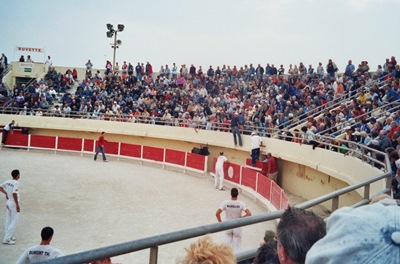
[Thursday 7 October : Les St Maries de-la-Mer, France] Went horse riding in the Camargue, through dunes, marshes and along the beach; it was only my second time on a horse, and it was far more pleasant than my first experience (in Ireland in 1990). The weather was great, and in the afternoon we lazed on the beach and swam in the Mediterranean Sea (well, two of us swam - Karen rarely puts her feet in water that isn't tropical in temperature).
[Friday 8 October : Carcassonne, France] It proved quite difficult to get to Carcassonne, not very far west of St Maries de-la-Mer. We had to get a taxi to Grau-du-Roi (on the western edge of the Camargue) via Aigues-Mortes, La Grande Motte and Port Camargue, then a bus from Grau-du-Roi to Montpellier. In Montpellier we had to take a tram to the train station (Montpellier's trams are VERY slick), from where we had to catch two trains - first to Narbonne, then a change of trains, before reaching Carcassonne late in the afternoon. The trip through the Camargue brought back memories of when I'd driven through the area in my own car way back in 1987. We walked some distance from Carcassonne train station through the new town before finding a great place to stay on a side street just below the walls of the old town - very convenient.
[Saturday 9 October : Carcassonne, France] Carcassonne is stunning. The old town was painstakingly (although somewhat inaccurately) restored in the 19'th century and is entirely surrounded by double city walls. It is now a UNESCO world heritage site and unfortunately overrun by tourists. Cars are not allowed inside. That night we had a delicious dinner of Cassoulet (the local delicacy, a stew of pork, goose, sausage and beans) at a restaurant in the old town.
[Sunday 10 October : Carcassonne, France] Explored Carcassonne, went on the castle tour and visited the macabre but fascinating Museum of Torture. This museum documents in graphic detail the many mind-bogglingly sick ways that people in medieval times were tortured, often merely because they were suspected of (say) witchcraft. The museum was mostly devoted to the means of torture used during the Inquisition; some of the instruments on display are truly the stuff of nightmares. The most incredible part of all this cruelty was that a great deal of it was perpetrated in the name of religion.
In the afternoon I strolled into the new town, visited a few car rental agencies and booked a car for us for the next day.
[Monday 11 October : Carcassonne, France] Early in the morning we collected our rental car (a tiny 3-door Puegeot hatchback), drove out of Carcassonne and visited the caves of Labouiche near Foix. These caves contain the longest subterranean river in Europe - you climb down then go by boat for several kilometres through the caves.
From there we drove to the ruined castle of Montségur, which is on the top of a VERY steep hill and required a stiff 30 minute walk to reach it. This castle was the last outpost of the Cathars before they were all eradicated during the Albigensian Crusades. However, the ruined castle that is there today is not the original Cathar stronghold - that was entirely torn down after the Cathars surrendered. Thereafter a new castle was built on the same site, and the ruin of this latter castle is what remains. Below the castle is the tiny village of Montségur, which has a small but fascinating museum.
After the final destruction of Montségur in March 1244 the Cathars effectively disappeared and today the sect no longer exists. The ruined Cathar castle is an eerie place with a mysterious history, all the more so because over 200 people (who refused to recant their faith when the castle was overrun) were burnt alive en masse in a huge pyre at the bottom the hill. Although the French government today recognizes Montségur as a site of historical significance, no attempt has been made to publicise it or make it accessible to tourists - there are a few parking spaces on the road below and a rough, uneven track up the hill to a pile of stones. That's it. It is almost as if the memory of the Cathars is still being suppressed to this day ...
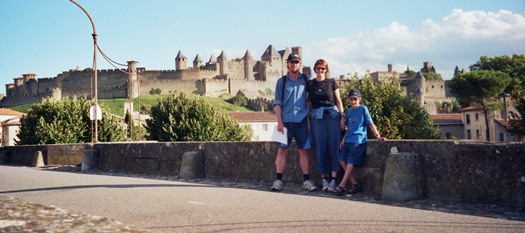
[Tuesday 12 October : Paris, France] Spent all day on the train getting back to Paris, a pleasant and relaxing ride after our non-stop travelling of the previous several days. Luckily we had an 8-seat compartment to ourselves for the entire trip.
[Wednesday 13 October : Paris, France] We went to the Eiffel Tower, walked up the first two levels then took the mandatory elevator to the top (it was FREEZING cold up there). On the way back to our hotel to collect our luggage we stopped at the massive ten-storey department store Galleries Lafayette and used up our last few Euros (more accurately, Karen used our last few Euros to buy chocolate).
We had time for a quick lunch before taking the train (RER) to the airport for our late-afternoon flight back to South Africa, but it turned out to be a close thing - there was a problem at the St Michel Metro station and this meant we had to take a different route to the airport. In the end we just made it in time.
[Thursday 14 October 2004 : Cape Town, South Africa] And that was the end of our trip ... next stop Thailand and Cambodia in 2006.